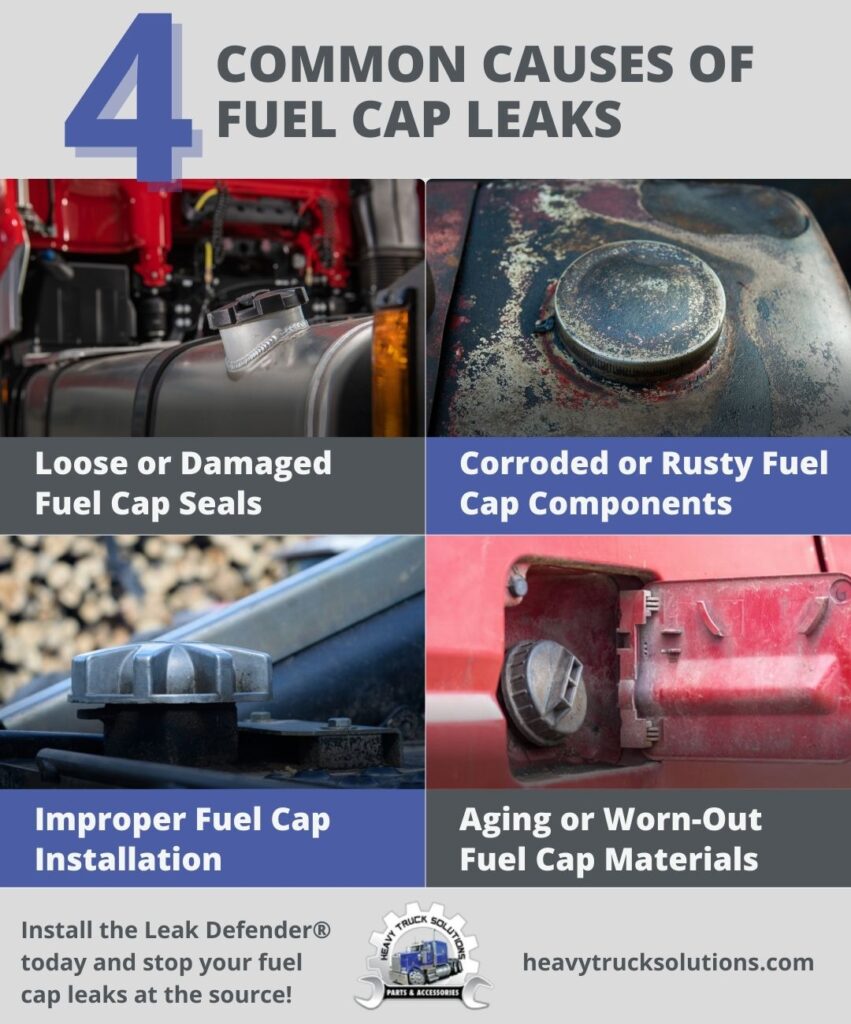How-To
How to Stop Fuel Cap Leaks on Heavy Duty Trucks
Fuel cap leaks are a notorious issue with all makes and models of heavy-duty trucks. This not only looks bad but can cause fuel to leak out onto the road and become a DOT compliance issue as the Department of Transportation (DOT) has mandated that the fuel systems on heavy trucks are properly sealed and free from leaks.
We run a trucking company and had the issue with our fleet of Kenworth, Peterbilt, and International trucks and have come across Freightliner, Volvo, Mack, etc. all having this issue with really no remedy. One of our trucks was red flagged which obviously cost us a lot of money due to downtime. On our quest to fix this issue, we tried a few of the solutions listed below, but most failed or worked for just a short time and others were out of the question.
We have given each solution a low, medium or high score on the following: reliability (will this solution perform consistently well?), cost (how much does this solution cost compared to the others?), and difficulty (how much time will need to be invested to implement the solution?).
Why Do Fuel Caps Leak?

Let’s start by explaining why fuel caps leak as you need to know what is going on in order to fix it. Typically, your fuel neck and/or fuel cap is the problem as it wears with everyday use…the threads will get scratches, chips, dents, etc. when the fuel nozzle is inserted into your fuel tank for refueling and when the fuel cap is taken on and off your fuel neck. The o-rings/gaskets can no longer properly seal, and fuel will leak onto your tank. Sometimes a fuel cap will leak due to something as simple as a deteriorating gasket/o-ring.
Now on to how we, as well as other fleet owners and truckers, have stopped leaking fuel caps (ahem, including the product we invented) on heavy duty trucks.
1. INSTALL THE LEAK DEFENDER®
Reliability: High
Cost: Medium
Difficulty: Low
I am going to first suggest the patented product we invented, the Leak Defender®, as it is genuinely the only product out there that stops fuel cap leaks for good…AND it’s 100% money-back guaranteed to do so! Like I mentioned before, we have a trucking company and experienced leaking fuel caps on our trucks. We tried or considered all the below options and because they did not live up to our expectations, we developed our own solution.
The Leak Defender® is a 2-piece fuel neck replacement system consisting of a collar and fuel cap. It attaches to and replaces your old, worn fuel filler neck and is securely fastened with set screws. The cap and collar are sealed with military grade nitrile o-rings…commonly referred to as a Buna or NBR o-rings. It’s machined from billet aluminum producing a very high-strength, high-quality part. It’s DOT compliant, installs in just minutes and cost just $249.99! Win-Win!
2. Replace Rubber Gaskets/O-Rings
Reliability: Low
Cost: Low
Difficulty: Low
This is typically one of the first things someone tries. O-rings/gaskets are the seals that are compressed between the fuel cap and the fuel neck. They help join these surfaces together and prevent leakage of fuel. The idea here is that the o-ring has started to deteriorate and is no longer properly sealing. If this is the case for you, then great…. it’s a quick, easy and cheap solution!
Keep in mind, just like anything else, all o-rings are not created equal and they have a limited lifespan. They come in a variety of materials each with strengths and weaknesses. Each provides optimal general-purpose sealing options but differ in terms of compression set, tensile strength, flexibility, and fuel, oil, temperature and abrasion resistance. Choose a material that works best for your application. And replace them as you notice wear.
3. Double Up on Gaskets/O-Rings
Reliability: Low
Cost: Low
Difficulty: Low
The idea here is to get a tighter seal. Over time the o-ring/gasket can fail to return to its original size after release from a constant compressive load. The amount of material that fails to return to its original size is called a compression set. Compression set failure produces flat surfaces on both sides of the o-ring’s cross-section, which reduces its sealing potential. Doubling up on o-rings/gaskets could potentially work for a limited time but replacing it altogether may be a better option.
Like we said above, o-rings/gaskets on have a limited lifespan and will need to be replaced as you notice wear.
4. Replace Fuel Cap(s)
Reliability: Low
Cost: Medium
Difficulty: Low
The idea here is that the threads on your fuel cap have worn. This will work if that is the case and the threads on your fuel filler neck are intact. This may be the case, but typically if you have worn your fuel cap threads then the threads on your fuel filler neck are also worn.
Keep in mind, this is just a temporary solution as eventually it will wear like your old fuel cap due to its material makeup and need to be replaced. The cost of a fuel cap ranges anywhere from approximately $40 – $150 each, like this fuel cap here that is about $75 with tax + shipping, and can quickly add up to a significant amount over the life of the truck.
5. File the Fuel Neck Threads
Reliability: Low
Cost: Low
Difficulty: Low
If replacing and/or doubling up on o-rings/gaskets and replacing your fuel cap doesn’t work for you, then your culprit is more than likely a worn fuel neck (this is usually the case). We don’t recommend this, but filing the threads which have scratches, chips, dents, etc. until smooth can help stop fuel cap leaks temporarily until the fuel neck starts to chip away again.
Keep in mind, just like o-rings (and anything else), fuel necks are not created equal. The material and grade used to construct a fuel tank varies and each has its own strengths and weaknesses. The three most common materials used in the manufacture of fuel tanks are aluminum, steel, and stainless steel. Each differ in terms of formability, weldability, corrosion resistance, and strength amongst other things, so this may work temporarily, but due to its material makeup it will more than likely have the same issue down the road. Also, beware as the fillings may drop into your fuel.
6. Replace Fuel Neck(s)
Reliability: Low
Cost: High
Difficulty: High
Another option is to replace your entire fuel tank filler neck, which can help temporarily until the wear and tear of everyday fueling chip away at the fuel neck once again. Not to mention, it’s expensive…You would need to buy a new fuel neck like this one here, empty all that expensive diesel from your fuel tank, pay for a mechanic to weld on a new fuel neck and endure the cost of downtime!
If you go this route, we recommend you find a certified shop as welding on a new fuel neck without going through the proper channels voids your fuel tanks certification and is not DOT compliant. The manufacture of diesel fuel tanks is strictly governed by safety regulations. Fuel tanks of a capacity greater than 25 US gallons must adhere to specifications for spillage, leakage, mounting, impact survivability, weld requirements, venting and a host of other stipulations.
7. Replace Fuel Tank(s)
Reliability: Low
Cost: High
Difficulty: High
Replacing our fuel tanks with one like this was what we considered as our last option as it is clearly the most expensive one! I don’t think I need to mention why. And, this is also a temporary solution as the wear and tear of everyday fueling will just chip away at the fuel neck once again.
